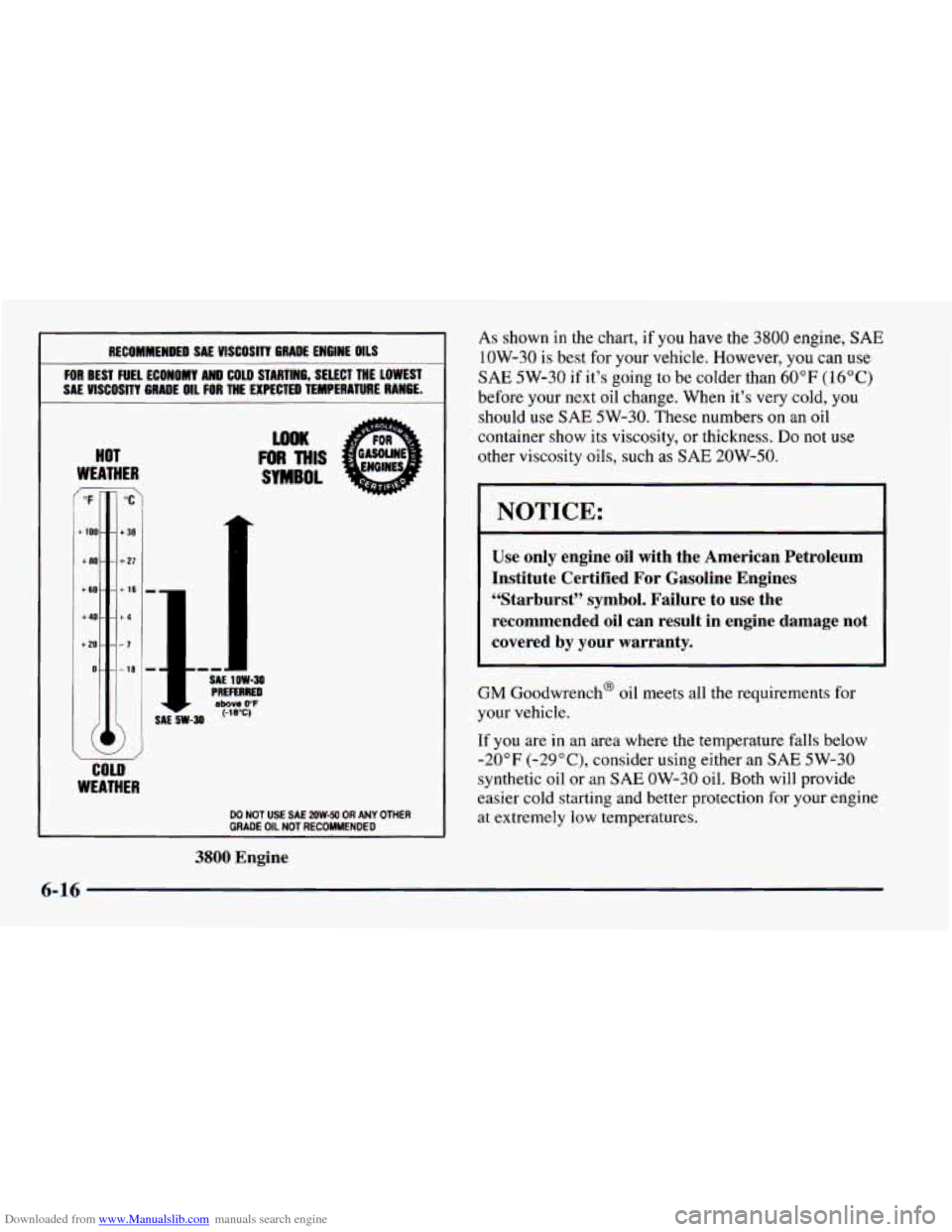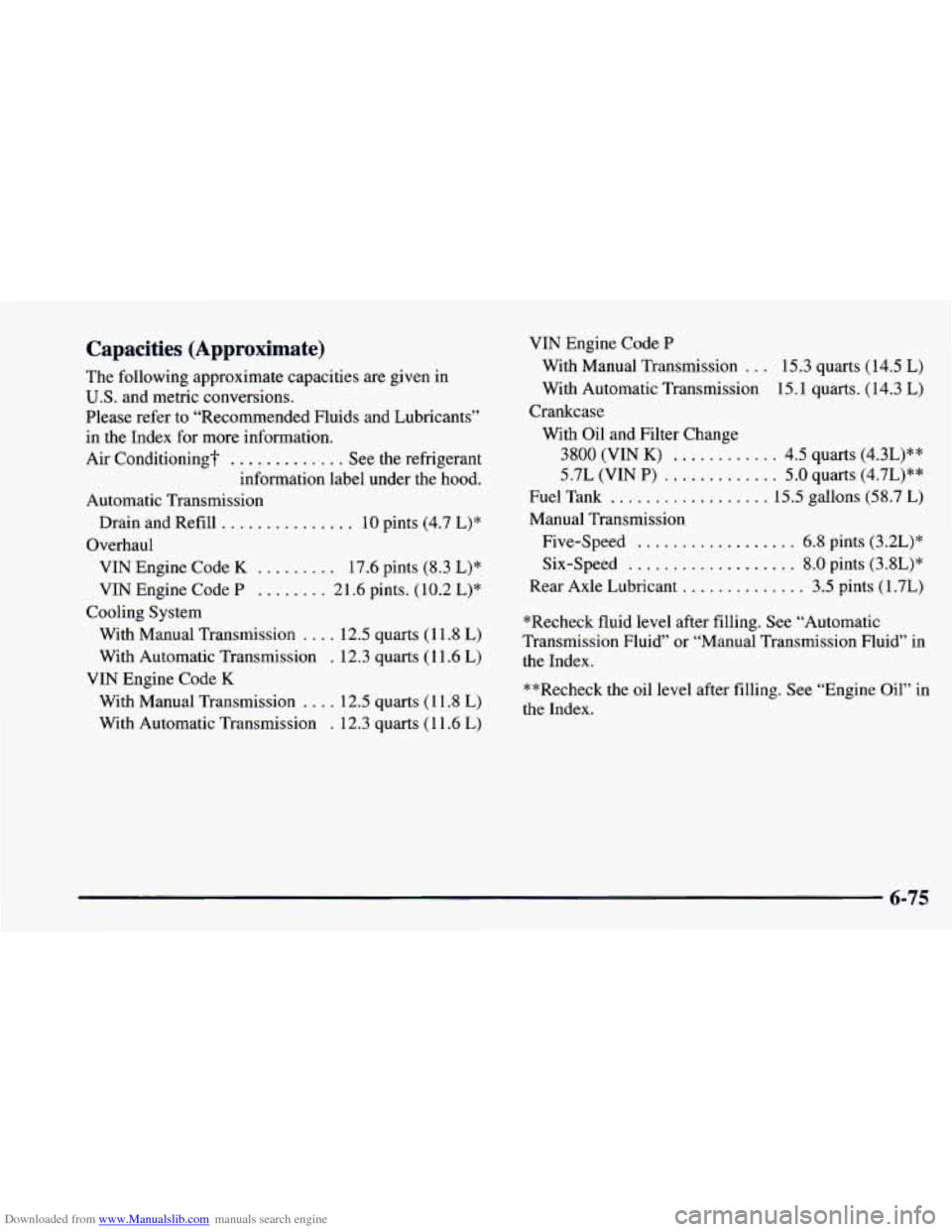1997 CHEVROLET CAMARO recommended oil
[x] Cancel search: recommended oilPage 187 of 404

Downloaded from www.Manualslib.com manuals search engine The exit speed is usually posted.
Reduce your speed according to your speedometer, not
to your sense
of motion. After driving for any distance
at higher speeds, you may tend to think you are going
slower than you actually are.
Before Leaving on a Long Trip
Make sure you’re ready. Try to be well rested. If you
must start when you’re not fresh
-- such as after a day’s
work
-- don’t plan to make too many miles that first part
of the journey. Wear comfortable clothing and shoes you
can easily drive in.
Is your vehicle ready for a long trip? If you keep it
serviced and maintained, it’s ready to go. If it needs
service, have it done before starting out.
Of course,
you’ll find experienced and able service experts in
Chevrolet dealerships all across North America. They’ll
be ready and willing to help if you need it. Here
are some things you can check before a trip:
0
0
0
0
0
0
0
Windshield Washer Fluid: Is the reservoir full? Are
all windows clean inside and outside?
Wiper Blades: Are they in good shape?
Fuel, Engine Oil, Other Fluids: Have you checked
all levels?
Lamps: Are they all working? Are the lenses clean?
Tires: They are vitally important to a safe,
trouble-free trip. Is the tread good enough for
long-distance driving? Are the tires all inflated to
the recommended pressure?
Weather Forecasts: What’s the weather outlook
along your route? Should you delay your trip a short time to avoid a major storm system?
Maps: Do you have up-to-date maps?
4-23
Page 222 of 404

Downloaded from www.Manualslib.com manuals search engine How to Add Coolant to the Coolant
Recovery Tank
If you haven’t found a problem yet, but the coolant level
isn’t at FULL COLD, add a
50/50 mixture of clean water
(preferably distilled) and DEX-COOL@ (silicate-free)
antifreeze
at the coolant recovery tank. (See “Engine
Coolant’’ in the Index for more information.)
A CAUTION:
Adding only plain water to your cooling system
can be dangerous. Plain water, or some other
liquid like alcohol, can boil before the proper
coolant mix will. Your vehicle’s coolant warning
system
is set for the proper coolant mix.
CAUTION: (Continued)
With plain water or the wrong mix, your engine
could get
too hot but you wouldn’t get the
overheat warning. Your engine could catch fire
and you or others could be burned.
Use a 50/50
mix of clean water and DEX-COOL@ coolant.
I NOTICE:
~
In cold weather, water can freeze and crack the
engine, radiator, heater core and other parts.
Use the recommended coolant and the proper
coolant mix.
5-18
Page 251 of 404

Downloaded from www.Manualslib.com manuals search engine To provide cleaner air, all gasolines in the United States
are now required to contain additives that will help
prevent deposits from forming in your engine and fuel
system, allowing your emission control system to
function properly. Therefore,
you should not have
to add anything to the fuel. In addition, gasolines
containing oxygenates, such as ethers and ethanol, and
reformulated gasolines may be available in your area to
help clean the air. General Motors recommends that
you
use these gasolines if they comply with the
specifications described earlier.
NOTICE:
Your vehicle was not designed for fuel that
contains methanol. Don’t use
it. It can corrode
metal parts in your fuel system and also damage
plastic and rubber parts. That damage wouldn’t
be covered under your warranty.
Fuels in Foreign Countries
If you plan on driving in another country outside the
United States or Canada, the proper fuel may be hard to
find. Never use leaded gasoline or any other fuel not
recommended in the previous
text on fuel. Costly repairs
caused by use of improper fuel wouldn’t be covered by
your warranty.
To check on fuel availability, ask an auto club, or
contact a major oil company that does business in the
country where you’ll be driving.
You can also write us at the following address for
advice. Just tell
us where you’re going and give your
Vehicle Identification Number
(VIN).
General Motors International Product Center
1908 Colonel Sam Drive
Oshawa, Ontario
LlH 8P7
6-5
Page 260 of 404

Downloaded from www.Manualslib.com manuals search engine When to Add Oil
If the oil is at or below the ADD line, then you’ll need
to add some oil. But you must use the right kind. This
part explains what kind of oil to use. For crankcase
capacity, see “Capacities and Specifications” in
the Index.
What Kind of Oil to Use
Oils recommended for your vehicle can be identified by
looking for the “Starburst” symbol. This symbol
indicates that the oil has been certified by the American
Petroleum Institute
(API). Do not use any oil which
does not
carry this Starburst symbol.
NOTICE:
I
Don’t add too much oil. If your engine has so
much oil that the oil level gets above the
cross-hatched area upper mark that shows
the proper operating range, your engine could
be damaged.
The oil fill cap is located on the valve cover near the
oil dipstick.
Just
fill it enough to put the level somewhere in the
proper operating range. Push the dipstick all the way
back
in when you’re through. If you
change your own oil,
be sure you use oil that has
the Starburst symbol on the
front of the oil container.
If
you have your oil changed
for you, be sure the oil put
into your engine is
American Petroleum
Institute certified for
gasoline engines.
You should also use the proper viscosity oil
for your
vehicle, as shown in the following chart:
6-14
Page 261 of 404

Downloaded from www.Manualslib.com manuals search engine RECOMMENDED SAE VISCOSITY GRADE ENGINE OILS
FOR BEST FUEL ECONOMY AND COLD STARTING, SELECT THE LOWEST
SAE
VISCOSITY GRADE 011 FOR THE EXPECTED TEMPERATURE RANGE.
HOT
WEATHER
WOK
FOR THIS
SYMBOL
"F
+ 100-
+ 80 -
+ 60 -
+40-
+ 20 -
0-
\I
SAE SW-M PREFERRED
I SAE I law-30
COLD
WEATHER
DO NOT USE SAE 2OW-50 OR ANY OTHER
GRADE OIL NOT RECOMMENDED
5.7L Engine
As shown in the chart, if you have the 5.7L engine,
SAE 5W-30 is best for your vehicle. However, you can
use SAE 1OW-30 if it's going to be 0°F (-18°C) or
above. These numbers on an oil container show its
viscosity, or thickness.
Do not use other viscosity oils,
such as
SAE 20W-50.
6-15
Page 262 of 404

Downloaded from www.Manualslib.com manuals search engine RECOMMENDED SAE VlSCOSlTT GRADE ENGINE OILS
FOR BEST FUEL ECONOMY AND COLD STARTING, SELECT THE LOWEST
SAE VISCOSITY GRADE
OIL FOR THE EXPECTED TEMPERATURE RANGE.
HOT
WEATHER
WOK
FOR MIS
SYMBOL
wi
COLD
WEATHER
DO NOT USE SA€ 2OW-50 OR ANY OTHER GRADE OIL NOT RECOMMENDED
3800 Engine
As shown in the chart, if you have the 3800 engine, SAE
1OW-30 is best for your vehicle. However, you can use
SAE 5W-30 if it’s going to be colder than 60°F (16°C)
before your next oil change. When it’s very cold, you
should use
SAE 5W-30. These numbers on an oil
container show its viscosity,
or thickness. Do not use
other viscosity oils, such as SAE 20W-50.
NOTICE:
Use only engine oil with the American Petroleum
Institute Certified For Gasoline Engines “Starburst” symbol. Failure to use the
recommended oil can result in engine damage not
covered by your warranty.
GM Goodwrench@ oil meets all the requirements for
your vehicle.
If you are in an area where the temperature falls below
-20°F (-29”C), consider using either an SAE 5W-30
synthetic oil or an
SAE OW-30 oil. Both will provide
easier cold starting and better protection for your engine
at extremely low temperatures.
6-16
Page 271 of 404

Downloaded from www.Manualslib.com manuals search engine How to Add Fluid
Refer to the Maintenance Schedule to determine what
kind of transmission fluid to use. See “Recommended
Fluids and Lubricants”
in the Index.
Add fluid only after checking the transmission fluid
HOT. (A COLD check is used only as a reference.) If the
fluid level is low, add only enough
of the proper fluid to
bring the level up
to the HOT area for a hot check. It
doesn’t take much fluid, generally less than
one pint
(0.5 L). Don’t ove ZZ. We recommend you use only fluid
labeled DEXRON -111, because fluid with that label is
made especially for your automatic transmission. Damage
caused by fluid other than DEXRON-I11
is not covered
by your new vehicle warranty.
%!
After adding fluid, recheck the fluid level as
When the correct fluid level is obtained, push the
described
under
“How to Check.”
dipstick back
in all the way.
Manual Transmission Fluid
When to Check
A good time to have it checked is when the engine oil is
changed. However, the fluid in your manual
transmission doesn’t require changing.
How to Check
Because this operation can be difficult, you may
choose
to have this done at your Chevrolet dealership
Service Department.
If
you do it yourself, be sure to follow all the
instructions here, or
you could get a false reading.
NOTICE:
Too much or too little fluid can damage your
transmission.
Too much can mean that some of
the fluid could come out and fail on hot engine
parts or exhaust system parts, starting a fire. Be
sure
to get an accurate reading if you check your
transmission fluid.
6-25
Page 321 of 404

Downloaded from www.Manualslib.com manuals search engine Capacities (Approximate)
The following approximate capacities are given in
U.S. and metric conversions.
Please refer to “Recommended Fluids and Lubricants”
in the Index for more information.
Air Conditioning?
............. See the refrigerant
information label under the hood.
Automatic Transmission
Drain and Refill
............... 10 pints (4.7 L)*
Overhaul VIN Engine Code
K ......... 17.6 pints (8.3 L)*
VIN Engine Code P ........ 21.6 pints. (10.2 L)*
With Manual Transmission
.... 12.5 quarts (1 1.8 L)
With Automatic Transmission
. 12.3 quarts (1 1.6 L)
With Manual Transmission
.... 12.5 quarts (1 1.8 L)
With Automatic Transmission
. 12.3 quarts (1 1.6 L)
Cooling System
VIN Engine Code
K
VIN Engine Code P
With Manual Transmission
... 15.3 quarts (14.5 L)
With Automatic Transmission 15.1 quarts. (14.3 L)
With Oil and Filter Change
Crankcase
3800 (VIN K) ............ 4.5
quarts (4.3L)**
5.7L (VIN
P) ............. 5.0 quarts (4.7L)**
Fuel Tank .................. 15.5 gallons (58.7 L)
Manual Transmission
Five-Speed
.................. 6.8 pints (3.2L)*
Six-Speed
................... 8.0 pints (3.8L)*
Rear Axle Lubricant
.............. 3.5 pints (1.7L)
*Recheck fluid level after filling. See “Automatic
Transmission Fluid” or “Manual Transmission Fluid” in
the Index.
**Recheck the oil level after filling. See “Engine
Oil” in
the Index.
6-75